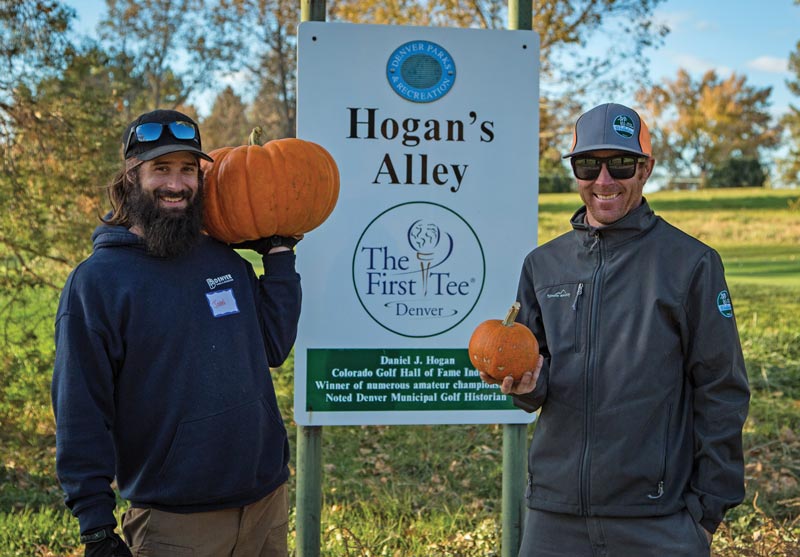
Denver Golf horticulturist John Swain (left) and Wellshire Golf Course superintendent Scott Ellis with some of the harvest from the course’s pumpkin patch. Photo by Tanner Gibas
The city and county of Denver’s seven municipal golf courses encompass approximately 1,000 acres, with a rich golf history dating back as far as 1895.
One such notable course in Denver’s portfolio is Wellshire Golf Course, where golf legend Ben Hogan won the 1948 Denver Open. Not much of Wellshire’s layout has changed since the original 1926 Donald Ross design, and it is a highly sought-after public course, hosting as many as 350 rounds per day.
Along with the other Denver golf courses, Wellshire has made great strides to maintain this high volume of play with an eye toward sustainability, and the course has been a Certified Audubon Cooperative Sanctuary since 2012.
Wellshire superintendent Scott Ellis has a saying: “Don’t just think outside the box. Break the box!”
Ellis, a GCSAA Class A superintendent and 23-year association member, recently led the course through an irrigation renovation and into the books with Denver’s first HDPE Toro decoder system, with 30 percent annual energy savings. Ellis continues to improve water efficiencies and is one of the most water-wise superintendents in the region. He has been known to say, “If we can save water, why can’t we save the planet?”
With this in mind, Ellis and golf horticulturist John Swain embarked on a journey to push the boundaries of conventional sustainability. Beginning with beehives and pollinator gardens, the pair eventually applied their talents to food-crop production with Denver Golf’s first pumpkin patch.
Wellshire’s parkland style of golf doesn’t lend itself to promoting vast amounts of natural areas. About 10 acres are set aside for conservation. A half-acre of this space caught Ellis’ attention as a perfect area to convert to a garden, and in 2017, he established a pumpkin patch in the space. While an errant golf shot into the patch might be unplayable, the patch is viewed as an enhancement to the course rather than a hazard. Proceeds from the sale of pumpkins that first year went to The First Tee of Denver.
In 2018, Swain diversified the patch with a variety of pumpkins and wildflowers. Growing organic pumpkins is certainly not low-maintenance — Swain and his assistant Tom Emory devoted long hours to hand-weeding and straw-mulching the patch.
Swain has transitioned other Denver Golf landscapes from purely aesthetic plant materials into vegetable gardens. Approximately 500 pounds of organic vegetables from the Harvard Gulch Golf Course garden are donated annually to a local nonprofit restaurant that provides free and reduced-cost meals. Thanks to Swain’s horticultural expertise, the course’s landscape is as beautiful as it is delicious.
Fall of 2018 marked a milestone for the Wellshire pumpkin patch, with a yield of more than 300 pumpkins — pie, jack-o’-lantern, giant and a ghostly blue variety. Previously, Wellshire had donated pumpkins directly to Denver recreation centers, but this year, Wellshire partnered with My Denver — a taxpayer-supported program that provides free access for kids ages 5-18 to Denver’s recreation centers, pools and cultural facilities — to bring the kids to the pumpkins.
Golf staff staged the pumpkins throughout the conservation area surrounding the junior course (the pumpkin patch was still too deep for children to navigate). The youngsters ventured into the tall grass to hunt, pick and take home any pumpkin they could carry. Many of the kids may not have otherwise had an opportunity to pick a pumpkin from a field. On that day, at a golf course, in the heart of the city, they were able to experience a fall pumpkin harvest.
The First Tee of Denver supported the event by providing the young visitors with an introduction to golf at the junior course. Additional pumpkins were shared with Denver recreation centers, and extras were placed for sale at Denver courses. Funds will channel back into the golf environmental programs so that Ellis and Swain can grow their project and reach more children. (A few of the pumpkins met a different fate, as Ellis also turned some into pies for his staff to enjoy.)
It is critical that metropolitan areas like Denver diversify green space and lend their experts from all disciplines to share the art and science of agriculture with future generations. Just as conservation areas can be carved out of a golf course, small experiential gardens can be set aside for little hands to get dirty and young minds to grow. Superintendents and horticulturists like Ellis and Swain can apply their skills in unconventional ways to make a difference in their communities and in the environment.
Pamela C. Smith, CGCS, is an attorney and director of agronomy for a large city. She is a 27-year member of GCSAA.